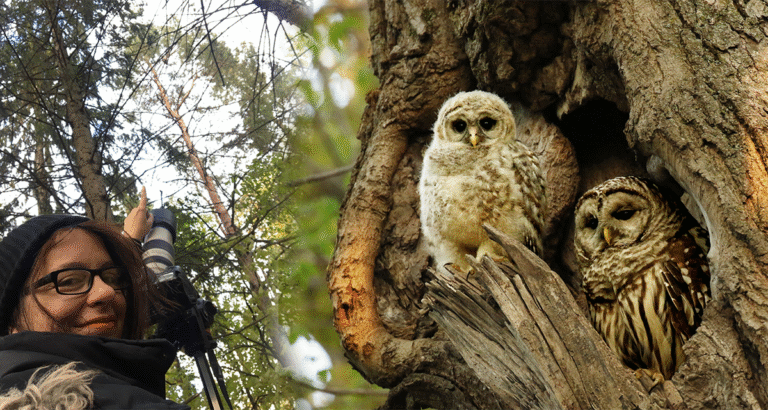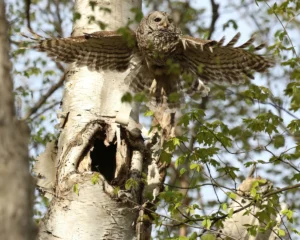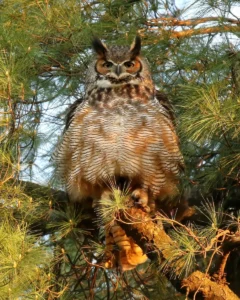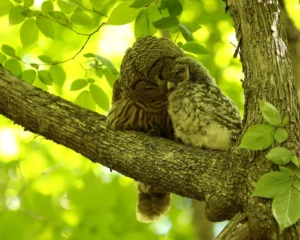
A Conversation with “Thee Owl Queen”
Heather King has an extraordinary bond and a special understanding of owls. It is a derivative of her immersion in owl societies
- Wayne Pacelle
I’ve made a public case that the U.S. Fish and Wildlife Service’s plan to orchestrate the killing of 450,000+ North American barred owls is costly, unworkable, and inhumane, and I am asking Congress to approve H.J. Res. 111 and S.J. Res 69 to prevent an unprecedented onslaught against these raptors, who have been protected for decades by the Migratory Bird Treaty Act. I’ve invoked practical and objective arguments but not talked much about the owls and what’s at stake for them as individuals.
During the course of this public debate, I’ve heard from owl lovers who’ve told me more of the backstory of the nocturnal owls — their characteristics, habits, and even their empathy. Heather King (aka “Thee Owl Queen” on Instagram and Facebook) has dazzled me with her photographs and videos and understanding of owls.
Over the past 15 years, Thee Owl Queen has put thousands of hours into owl observation in the forests of Ontario and Quebec and brought owl knowledge to her masses of followers on Facebook and Instagram. I spoke with her about the barred owl Management Strategy but also about the owls and their lives.
Wayne Pacelle: How do you find so many owls and get so close?
Heather King: What most would call the greatest misfortune of my life — late-stage Lyme disease — brought me face to face with owls. Faced with two paths — to give all my energy to my illness or to pour myself into something greater — I chose owls.
I devoted myself fully: learning which species live in my province, my country, and across the United States. I studied their nesting seasons, when their young would emerge, their favored foods, their habitats. I built my life around their rhythms. I drove for hours, walked countless trails, visited forests and fields, and earned the trust of farmers who began calling me when owls returned to their land. Owls became my teachers, my healers, my compass.
I work from a respectful distance, often farther back than other photographers, because their well-being always comes first. My equipment is simple, a Nikon P1000 point-and-shoot that reaches 3000mm, allowing me to capture their lives in extraordinary detail without disturbing them. I don’t need the most expensive gear, but only patience, devotion, and reverence. Finding owls is not about luck. It’s about years of listening, watching, and learning the secret language of the forest.

WP: You’ve watched barred owl families and seen their struggles. Your photography and videos exhibit such compassion for these birds. What first drew you to barred owls, and why are they such a big part of your work and advocacy?
HK: Out of all the owls I’ve observed and filmed over the last 15 years, barred owls hold my heart in a way no others do. They are the embodiment of what every family should be: devoted, tender, and steadfast. A bonded pair is not just together for a season; they are truly lifelong partners. They preen one another, duet, and reaffirm their bond not only during nesting but throughout the year. They are, in every sense, true love birds.
I will never forget the first time I watched a barred owl mother with her baby, just four days out of the nest. She leaned down and preened him for nearly 20 minutes, calming him with every gentle stroke of her beak. When she flew off, he cried out in distress, and without hesitation, she returned to soothe him again. I stood with my hand over my heart, weeping uncontrollably, because I had never witnessed love expressed so purely.
Great horned owls spend about eight weeks in the nest, but barred owls have barely half that time, just 28 to 32 days. Because they are cavity nesters, their young spend their earliest days sheltered inside a tree. When it’s time to leave, their wings are still underdeveloped, their flight feathers not fully grown. Instead of soaring, they parachute clumsily to the ground: wide-eyed, vulnerable, anxious, and yet full of wonder at the new world they’ve landed in. Witnessing those first wobbly moments on Earth is humbling beyond words.
For me, these owls fill something deeper than scientific curiosity. I never knew parental love myself. I was never hugged, never told “I love you” or “I’m proud of you.” I also live with severe anxiety. When I see a barred owl mother tending to her child’s fears, responding to his cries, filling him with comfort, it heals cracks in my heart that I thought would remain empty forever. Through them, I witness the kind of love and reassurance I never had.
WP: You’ve documented barred owl families up close. Could you share a moment that shows their intelligence, care for one another, or playfulness?
HK: In following a barred owl family for the very first time, I filmed the mother gently feeding her three chicks tiny pieces of chipmunk. She was so patient, carefully tearing off morsels one by one, turning feeding into a bonding ritual. But just as she was taking her time, the father arrived with a large vole. The chick quickly swallowed it whole, and I could see the mother’s heartbreak, her quiet moment of tenderness interrupted. Yet, with three mouths to feed in a forest where Great Horned Owls and Sharp-shinned Hawks were also raising young and competing, the father had to be practical. In that instant, I saw the unspoken balance between love and survival.
A week later, I returned and found the runt struggling with his first vole. He held it awkwardly in his talons, nibbling at it like a baby learning to eat. It was so innocent and endearing, exactly like watching a human toddler explore food for the first time. They are playful, clumsy, and curious, reminding us how much alike we truly are.
That same week, one of the fledglings was perched high on a branch when a squirrel came too close. The young owl panicked, puffing up and clacking its beak in distress. In an instant, both parents swooped in, one to comfort their anxious baby, the other to drive the squirrel away. It was a perfect display of both care and protection: intelligence in action, love in motion.
Barred owls are also incredibly affectionate and loyal. I have watched pairs preen each other and “kiss” in the canopy for 20 minutes at a time, and I see this not just with one pair, but across multiple families every year. Their bond is lifelong, and their devotion to one another is something to behold.
Their communication skills are extraordinary and often overlooked. They don’t just call “who cooks for you.” They have a vast range of sounds; soft murmurs, playful chuckles, alarm calls, even what I can only describe as arguments. This year, I heard a pair bicker over who should feed a squirrel to their young; it lasted nearly ten minutes, both on the ground and in the trees. It was like watching a human couple disagree over dinner.
Like human children, young barred owls cling to their mother, full of separation anxiety and fear as they face the world for the first time. They leave the nest sometimes after just four weeks, with wings not yet strong enough for true flight. They parachute clumsily to the ground, wide-eyed with wonder but also trembling with anxiety. They cry out for their mother, even when she is only 20 feet away, desperate for reassurance and comfort. And the mother gives it. She validates her babies’ fears, tending to them with tenderness and patience. If she senses one is falling behind, she will deliberately place food where she wants her owlet to be, guiding and encouraging progress in the gentlest way.

WP: Your online community calls you “Thee Owl Queen.” How has sharing your work online changed the way people think about barred owls, and how does it feel to have become a voice for them?
HK: When I post videos of a mother soothing her young, I often hear, “I wish I had that kind of love growing up.” When I share moments of a bonded pair preening and duetting, the comments flood in: “I hope I find a partner who will love me like this.” These owls touch people in the deepest, most human ways. They remind us of love, loyalty, and the kind of care we all long for.
Because of that, people no longer see barred owls as “just birds.” They see families, devotion, tenderness, and resilience. And once people feel that, they want to rally with me to protect them. The owls themselves have become their own best advocates, my role is simply to hold up the mirror and let the world see them.
Fifteen years ago, it was a snowy owl who saved me, and now it feels full circle: I’ve been given the chance to give back by protecting these earthbound, feathered angels.
The inhumane barred owl kill plan
WP: I know you detest the idea of our government shooting owls in the Pacific Coast states. Will orphaning swell the body count if this kill plan is implemented?
HK: The federal government nary mentions this additive mortality. What’s happening now is not just the loss of adult owls, but the silent loss of countless fledglings left behind.
Government-funded killing of barred owls in California, according to Animal Wellness Action, resumed in one California county weeks ago, right in the middle of baby season. At this stage, young barred owls are barely four months old. They are still clumsy, still developing their flight skills, and in many cases, their facial discs haven’t even fully grown in yet. I’ve been in the forests watching them perched together, playing, calling for their parents, still very much dependent.
Without their mothers and fathers, most of these young simply won’t survive. Even in natural conditions, only about one in three makes it to adulthood, due to predation from raccoons, great horned owls, and the immense challenge of learning to hunt on their own. When you remove the parents from that fragile equation, survival becomes almost impossible.
Every adult killed represents not just one death, but often an entire brood of young left to starve, to be picked off by predators, or to die frightened and alone. It magnifies the tragedy.
WP: You’ve honed your owl-identification skills through field study for years. Are you concerned about novice owl shooters — people who may do a half-hour on-line course to get clearance to shoot owls — will shoot spotted owls instead of barred owls?
HK: Novice owl shooters with a half-hour course? Are you kidding me? That has me very worried and has disaster written all over it. I’ve been studying owls for 15 years and owl lovers as well as nature enthusiasts constantly tell me of an owl they saw, and when I question them, they almost always misidentify the species. The barred and spotted owls look so similar and their offspring, the “sparred owls,” there’s no way a novice shooter will be able to distinguish.
WP: Given that barred owls are territorial, won’t the dispersal of the young result in the repopulation of forests previously cleansed of barred owls? That appears to be the key reason why so many scientists have said that this plan will put the United States on a treadmill it can never dismount.
HK: Once a territory is established, an adult pair defends it against others of their kind. This is nature’s way of keeping balance. When one or both members of a pair die, surrounding young owls disperse to fill the empty space. It becomes a constant cycle of death and replacement.
This is why killing cannot restore balance. The owls will always return, because they are not invaders, they are survivors. Their dispersal is not a flaw; it’s the very mechanism nature gave them to ensure their species endures. To overlook this is to misunderstand the most basic truth of owl behavior and forest ecology.
Rather than pouring endless resources into trying to erase them, we should be asking: why did they expand in the first place? The answer lies not in the owls themselves, but in the forests we fragmented, logged, and reshaped. If we address habitat loss, if we reconnect old-growth, if we invest in resilience, then all forest owls — not just one species — can coexist and thrive.
Labels and Mischaracterizations
WP: Some environmentalists have labeled barred owls as “bullies” or “invasive.” What do you wish people understood about why these labels are misleading?
HK: These owls are North American natives. They are adaptive and, like all wildlife, are simply trying to survive in a rapidly changing world not of their own making. To cast blame on them for doing what nature has equipped them to do feels more like a projection of human discomfort than a reflection of ecological reality.
WP: What do you wish some conservationists and the public better understood about barred owls’ place in North America?
HK: Much of the negative perception surrounding them stems from early narratives that were often based on limited data or framed through a narrow lens. Unfortunately, once these kinds of emotionally charged terms are introduced, they can stick, even when new research and firsthand observations paint a far more nuanced and compassionate picture.
As apex predators, they help regulate rodent populations, offering natural pest control that reduces crop damage and the potential spread of disease; ecological services that benefit both the environment and human communities.
WP: Tell me about great horned owls. They are present where you live in Ontario, but they also populate West Coast states. They actually predate on spotted owls and barred owls. If the United States steps up the assault on barred owls, would they logically target great horned owls based on their predatory behavior?
HK: Great horned owls are remarkably intelligent, elusive, and adaptable. They nest almost anywhere — from cliffs to bridges to heron nests. They are far more cautious around humans and would not be easily lured or managed through the same methods currently being used on barred owls. Targeting them would be disastrous and, as with the barred owl killing, unworkable in the long run. The result would be a never-ending, cruel campaign against our native owl species.
I always say I’m “Team Every Owl.”
In the end, I believe conservation should be grounded in empathy, transparency, and deep observation — not fear, blame, or convenience. The barred owl deserves better. All owls do.

Alternatives and the Bigger Picture
WP: Are there alternatives to competition and conflict between barred owls and spotted?
HK: Killing members of one species to “save” another doesn’t heal ecosystems, it creates new wounds. What deserves far more attention are the solutions rooted in habitat restoration, protecting old-growth forests, reconnecting fragmented landscapes, and reducing human-driven stressors like logging, rodenticides and other pesticides, and climate disruption. The spotted owl does not just need fewer barred owls; it needs more intact forests, more quiet, more space to thrive.
Barred owls are not a threat to biodiversity, they are biodiversity. To demonize them is to miss the message they carry: that ecosystems are not fragile glass cases, but living, breathing communities full of adaptive creatures. But competition and struggle are part of nature. We cannot manage those interactions. These interspecies dynamics are too complex and numerous for us to understand.
WP: The cull is projected to cost more than a billion dollars over 30 years. If you had the chance, how would you redirect those resources to help all forest owls more effectively?
HK: If I had a billion dollars to spend on owls, I would not spend a dime on bullets. I would place every ounce of that money into healing the very heart of the forest. Because when the forest thrives, all owls thrive.
I would invest in protecting old-growth forests, the cathedral homes where spotted owls, barred owls, and countless others belong. I would reconnect fragmented habitats so families of owls don’t find themselves cut off, starving, or forced to compete in the slivers of land we’ve left them. I would restore wild corridors where deer, elk, bears, and even tiny pollinators can move freely, making the forest whole again.
I would fund rehabilitation centers, giving injured owls and other wildlife a second chance at life. I would put resources into community education, so people learn that owls are not enemies but neighbors, vital threads in the tapestry of biodiversity. And I would direct resources into climate resilience, reforesting logged areas, protecting watersheds, and ensuring the forest can withstand the storms and fires of tomorrow.
Every dollar should go into life, not death. Into renewal, not erasure. Into listening to what the owls themselves have been showing us all along: if we care for the forest, it will care for everyone who depends on it.
With a billion dollars, we could make the forests sing again — with the voices of owls, wolves, thrushes, and the wind through ancient trees.
All photos courtesy of Heather King/Thee Owl Queen.
Dear reader: If you support substantive policy work to protect animals, please consider donating to Animal Wellness Action here. You can give any amount one time, or make it a monthly gift, as many of our supporters do. Thank you for helping us fight for all animals.